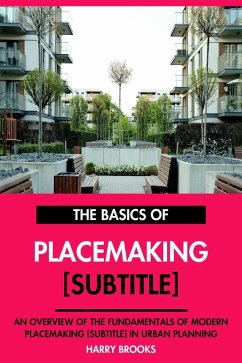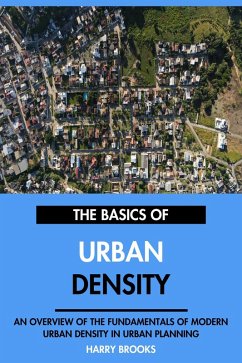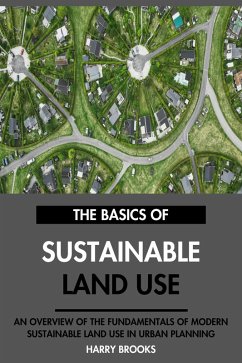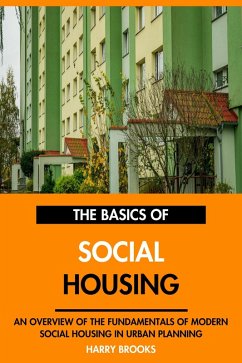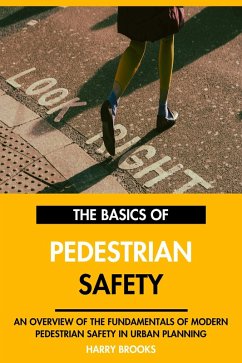
The Basics of Modern Walkable Neighborhoods: An Overview of the Fundamentals of Walkable Neighborhoods in Urban Planning. (eBook, ePUB)

PAYBACK Punkte
0 °P sammeln!
In recent years, the conversation surrounding urban living has shifted dramatically, with a growing emphasis on the importance of walkable neighborhoods. This eBook aims to explore the multifaceted nature of walkable neighborhoods, examining their significance in urban planning and their impact on community well-being. As cities expand and evolve, the need for environments that prioritize pedestrian access and promote sustainable living has become increasingly apparent.Walkable neighborhoods are not merely a trend; they represent a fundamental shift in how we envision urban spaces. The traditi...
In recent years, the conversation surrounding urban living has shifted dramatically, with a growing emphasis on the importance of walkable neighborhoods. This eBook aims to explore the multifaceted nature of walkable neighborhoods, examining their significance in urban planning and their impact on community well-being. As cities expand and evolve, the need for environments that prioritize pedestrian access and promote sustainable living has become increasingly apparent.
Walkable neighborhoods are not merely a trend; they represent a fundamental shift in how we envision urban spaces. The traditional model of car-centric development has led to numerous challenges, including traffic congestion, air pollution, and a disconnection among community members. In contrast, walkable neighborhoods foster a sense of community, encouraging residents to engage with one another and their environment. This eBook will delve into the principles that underpin walkable neighborhoods, providing readers with a comprehensive understanding of their benefits and the strategies necessary for their implementation.
Throughout this eBook, we will explore various aspects of walkable neighborhoods, including their design principles, the role of public transportation, and the importance of community involvement. Each chapter will provide detailed insights into how these elements work together to create vibrant, accessible, and sustainable urban environments. By examining successful case studies and best practices, readers will gain valuable knowledge that can be applied to their own communities.
As we embark on this journey to understand walkable neighborhoods, it is essential to recognize that the creation of these spaces is not solely the responsibility of urban planners and policymakers. Every individual has a role to play in advocating for and contributing to the development of walkable environments. Whether through community activism, participation in local planning processes, or simply by choosing to walk instead of drive, each person can make a difference.
This eBook is intended for a diverse audience, including urban planners, community organizers, policymakers, and anyone interested in the future of urban living. By fostering a deeper understanding of walkable neighborhoods, we hope to inspire action and encourage collaboration among stakeholders at all levels. Together, we can work towards creating urban spaces that prioritize people over cars, promote health and well-being, and foster a sense of belonging.
As you read through the chapters, consider how the principles of walkable neighborhoods can be applied to your own community. Reflect on the changes that could enhance the quality of life for residents and contribute to a more sustainable future. The journey towards walkable neighborhoods is one that requires commitment, creativity, and collaboration, but the rewards are well worth the effort.
Walkable neighborhoods are not merely a trend; they represent a fundamental shift in how we envision urban spaces. The traditional model of car-centric development has led to numerous challenges, including traffic congestion, air pollution, and a disconnection among community members. In contrast, walkable neighborhoods foster a sense of community, encouraging residents to engage with one another and their environment. This eBook will delve into the principles that underpin walkable neighborhoods, providing readers with a comprehensive understanding of their benefits and the strategies necessary for their implementation.
Throughout this eBook, we will explore various aspects of walkable neighborhoods, including their design principles, the role of public transportation, and the importance of community involvement. Each chapter will provide detailed insights into how these elements work together to create vibrant, accessible, and sustainable urban environments. By examining successful case studies and best practices, readers will gain valuable knowledge that can be applied to their own communities.
As we embark on this journey to understand walkable neighborhoods, it is essential to recognize that the creation of these spaces is not solely the responsibility of urban planners and policymakers. Every individual has a role to play in advocating for and contributing to the development of walkable environments. Whether through community activism, participation in local planning processes, or simply by choosing to walk instead of drive, each person can make a difference.
This eBook is intended for a diverse audience, including urban planners, community organizers, policymakers, and anyone interested in the future of urban living. By fostering a deeper understanding of walkable neighborhoods, we hope to inspire action and encourage collaboration among stakeholders at all levels. Together, we can work towards creating urban spaces that prioritize people over cars, promote health and well-being, and foster a sense of belonging.
As you read through the chapters, consider how the principles of walkable neighborhoods can be applied to your own community. Reflect on the changes that could enhance the quality of life for residents and contribute to a more sustainable future. The journey towards walkable neighborhoods is one that requires commitment, creativity, and collaboration, but the rewards are well worth the effort.
Dieser Download kann aus rechtlichen Gründen nur mit Rechnungsadresse in A, B, CY, CZ, D, DK, EW, E, FIN, F, GR, H, IRL, I, LT, L, LR, M, NL, PL, P, R, S, SLO, SK ausgeliefert werden.




